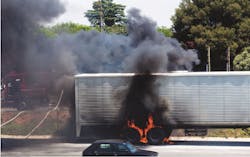Wheel-end monitors: Tech that helps avoid costly ‘thermal events’
Wheel ends are complicated components and are among the highest friction points on any tractor-trailer. So, trucking fleets hear a lot about “thermal events” at the wheel and, of course, at the tire. These events are real and expensive in extra maintenance and downtime and can be catastrophic to equipment, cargo, and even people.
The good news is this is an area on heavy-duty vehicles where several manufacturers have come to market with wheel-end monitoring technology—connected via onboard digital hubs to the cloud—that helps head off incidents, avoid costly downtime, and even identify maintenance errors that can cause wheel- and tire-related problems and failures.
See also: Solutions to an age-old tire problem are here
Safety, money, and equipment security motivate fleets to invest in any number of wheel-end monitoring systems. Many of these combine capabilities with tire-pressure monitoring technology—because tires arguably cause thermal events as often as any other component of the tractor or trailer wheel.
There are at least four major brands of wheel-end monitoring units on the market and others that exist as part of tire-pressure monitoring systems (TPMS). Two manufacturers of these sensor-based systems, ConMet, which makes the PreSet Plus SmartHub, and SKF, which produces the TraX, have studied the cost of key downtime events as part of their market research.
In its research, ConMet breaks down the costs of the following downtime events:
- Roadside repairs: $1,150 per event.
- Unplanned maintenance: $3,750, or four times the cost of each planned maintenance event.
- Catastrophic thermal events: More than $400,000 per event.
- Catastrophic wheel-offs: Up to—or more than—$1.5 million per event, which can include significant trailer and cargo damage and even fatalities.
The SKF TraX, a wheel-end monitoring system that is suitable for trucks, trailers, and buses, purports to slash unplanned maintenance and downtime costs by as much as $3.6 million yearly based on a fleet of 5,000 trailers and can help avoid thermal events that can cost up to $1.5 million per event.
The most costly and catastrophic of these events are “wheel-offs”—a total separation of the wheel and tire from the trailer or, in rarer instances, the tractor.
The National Transportation Safety Board (NTSB) estimated in 2012 that anywhere from 750 to 1,050 of these wheel-offs occur annually. That’s a small number compared to the number of trucks and trips 10 years since the NTSB’s estimate—but it’s too many for something that is preventable.
Guarding against tire fires
Phil Arnold, a field engineer with Michelin North America, told attendees at a fall meeting of American Trucking Associations’ Technology & Maintenance Council that rubber compounds begin to break down when tire temperatures exceed 250 degrees Fahrenheit. That’s when a blowout might occur that results from the deterioration of a tire.
The most extreme thermal event—fire—can begin when rubber reaches temperatures of 500 to 550 degrees Fahrenheit when flammable vapors are emitted from the tire. If an ignition source is present, the tire rubber will start burning at 650 to 700 degrees. Spontaneous combustion won’t occur until 850 to 900 degrees. (The normal operating temperature range for tires is between 100 and 150 degrees.)
See also: Inspect tires before long-haul trips this spring
“Tires contain a great deal of potential energy,” Arnold said. “They are like high-grade coal when they start to burn, and they are very difficult to extinguish.”
When a tire comes apart while driving, it’s usually the result of underinflation, Arnold added. Heat generated within the sidewalls as the tire flexes weakens the steel belts in the casing while softening the rubber to the point it eventually breaks down and the tire blows apart.
With tire fires, the heat source is the wheel end. Heat travels through the metal of the hub and through the wheel, where it comes into contact with the tire bead. Since the bead is built differently from the upper sidewall, the rubber there just gets hotter and hotter, until at some point it begins burning, rather than exploding as the casing might be because of underinflation.
The source of that heat is friction from either a deteriorating wheel bearing or a dragging brake. In the bearing’s case, failure usually stems from lack of lubrication. Brakes drag as a result of multiple causes.
Watching it all in the wheel area
What do these “connected” wheel-end technologies monitor to help avoid the most extreme or the most minor maintenance problems? Generally, anything that causes excess heating and vibration in the wheel system—anything that could cause a thermal event—even in the tire itself.
A typical wheel-end system consists of a seal, an inboard and outboard tapered bearing, and a hubcap. Additional wheel-end components include a spindle nut and wheel nuts, and some wheel-end systems may also contain a spacer that is meant to provide preset torquing.
Where wheel-end monitoring comes into play is when the trailer or tractor is in motion, hauling freight all those countless miles—extra sets of “eyes” on the equipment that can flag problems before or after the time when wheel ends are inspected to ensure safety and maximize performance.
Scheduled inspections (manufacturers can vary on their recommendations of a detailed inspection, from every 50,000 miles or every six months to 100,000 miles or every 12 months) help determine if a wheel-end repair is necessary, but monitoring systems give fleets and technicians clues about what might be amiss even before the trailer or tractor makes it to the shop for examination.
See also: Goodyear set to expand fleet tire management solutions
Monitoring systems are all about the data, according to Paul Washicko, VP and general manager of Vancouver, Washington-based ConMet’s digital business unit. He spoke at length with FleetOwner about the PreSet Plus SmartHub, which is ConMet’s connected wheel health- monitoring system integrated into a hub assembly that “generates actionable intelligence on wheel-end health,” according to the manufacturer.
Washicko said the low-power electronic sensor of the PreSet Plus SmartHub installs to the barrel of the wheel hub and transmits data to a “gateway” (installed on the bogey underneath a trailer or under the dash on a tractor), sending data from that “vehicle area network” to the SmartHub’s interface dashboard or to common trucking industry telematics products such as Geotab, Lytx, Samsara, Solera (Omnitracs), and others about wheel end, brake, bearing, and tire health.
“We have all this data, and we understand when a component gets to a temperature where it’s failing,” Washicko remarked. “We’ve taken advantage of the low-power electronics where we can actually put this out in the real world with fleets, monitoring temperature and vibration to see the health of the wheel end. We can separate out the frequencies of bearings and tires.”
Washicko added: “It’s interesting how we’re able to separate out those tire issues from bearing problems. We’ve been able to pick up a bearing failure so early that a mechanic is not able to detect it.” He also said ConMet’s system picks up on flat spots in tires, misalignments, and even objects lodged in tires based on their different frequencies detected by the sensor.
Alerts from the SmartHub most often pertain to tires, steer tires especially, he explained. ConMet partners with more than 60 fleets to use the SmartHub system, Washicko said.
“We find out remarkable things about this system every day,” he said. “Fleets don’t expect the alerts. We’re giving them visibility that we’ve never had before. We’ve picked up three different hub issues that would have been catastrophic, two were from damaged seals in the bearings. They had been in periodic maintenance [in fleet shops] and hadn’t been detected.”
This is the first part of a feature on wheel-end monitoring that ran in the July issue of FleetOwner magazine. Part 2 will appear later this week on fleetowner.com.
About the Author
Scott Achelpohl
Managing Editor
Scott Achelpohl is a former FleetOwner managing editor who wrote for the publication from 2021 to 2023. Since 2023, he has served as managing editor of Endeavor Business Media's Smart Industry, a FleetOwner affiliate.



